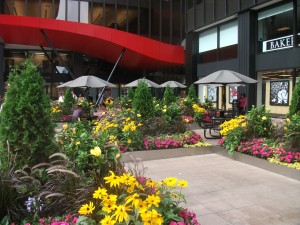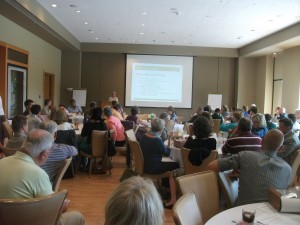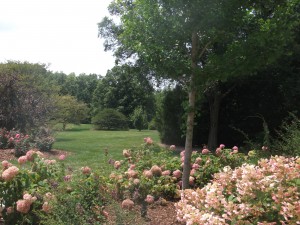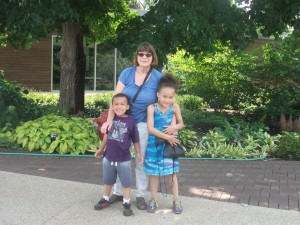It was one of those summer days this past Monday when I had been working hard to compose an online presentation and needed to come up for air. At a suitable point, I took a break and left my 12th-floor office in our downtown building on Michigan Avenue in Chicago, headed for the elevator, and went downstairs to the plaza in front of our building. It was a sunny day but not too hot, with a slight, pleasant breeze, and one can sit among the flowers at various small metal tables anchored in the cement, on seats that are equally anchored to the tables. It was time to smell the roses.

I looked for an empty table; it’s easier to find peace and quiet and less intrusive on someone else’s peace and quiet, though it means that five-sixths of the seats remain unoccupied when everyone does that, which they generally seem to do unless they are with someone they know. A woman was just leaving at one table, so I went there and sat down when she departed. I wanted to just look around and take in the scenery. Right now, some of that scenery involves construction on the other side of Michigan Avenue. A developer has been demolishing the old building at 200 N. Michigan for the last three months or more and is planning to build a new residential high-rise in its place. There is currently a big pit behind fences.
I was not alone for long. Looking for some place to sit, a gentleman about my age sat down, and I said hello politely. He was dressed considerably more casually and was very friendly. Somehow, a conversation began, which is not unusual for me because I am a gregarious sort, and so was he. I soon learned he was visiting Chicago as a tourist, had just recently flown in from Los Angeles, was originally form the United Kingdom, but was now living in Australia. His son was traveling with him and was somewhere nearby.
“We’re planning to drive Route 66,” he told me. I soon learned they were getting a rental car here in Chicago for a one-way trip back to Los Angeles. I had always thought of the Route 66 adventure as a uniquely American obsession, but I was about to learn otherwise.
“It’s been on my bucket list,” he said, “and now I’ll be able to cross it off.”
In contrast, I noted that I had not been to Australia, although I had been on a three-week visiting fellowship to New Zealand in 2008 with the Centre for Advanced Engineering in New Zealand at the University of Canterbury in Christchurch. He asked if I had seen the earthquake, and I said that regrettably, I had not been back. But I also noted happily that I had toured much of New Zealand at the time as part of the fellowship, that I had loved it, and that I woke up every morning having to remind myself that “I was actually getting paid to do this.” Then I noted that the generous Kiwis had often bestowed on me, after each presentation, a bottle of locally grown wine.
“Some of the best wine anywhere,” he said joyfully.
Then he told me that they planned to visit the Arch while in St. Louis, though he initially referred to it as “the Arches,” perhaps confusing it with those golden ones at McDonald’s, and I noted for him that there is only one, but that you can take an elevator to the top to see St. Louis from a height of about 600 feet, as I recalled. He seemed to relish the forthcoming opportunity, as did his son, who by then had joined us. Both looked slightly scruffy, but only in the manner of tourists who are enjoying a great adventure.
I said that someday, perhaps, taking a boat all the way from the top of the Mississippi River to the Gulf might be on my bucket list. “Is it navigable that far?” he asked. I assured him that river traffic moves as far north as the Twin Cities, and that by the time the river reaches New Orleans, it is typically about two miles wide.
He contemplated that thought for a minute in silence, a smile growing on his face. They don’t grow such rivers in the UK, and most of Australia is too dry to generate such a volume of water.
“The mighty Mississippi,” he finally said.
Unfortunately, I only had about ten minutes for a break before needing to join a conference call, so I excused myself and left the man and his son to their enjoyment of the urban pleasures of Chicago. They were clearly relaxed and set for their great adventure, a chance to scratch something off their bucket list. I did not learn how long they planned to stay in Chicago or when they were starting their trip down Route 66. But right about now, the two may be crossing the bridge into St. Louis from Illinois, and the old man, with his first up-close and personal encounter with Mark Twain’s highway, may be saying to himself once again, “The mighty Mississippi.”
He should have seen it when it was flooding.
Jim Schwab




